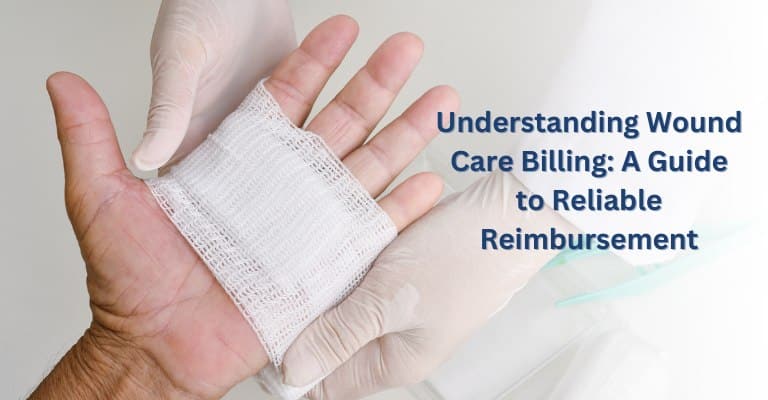
Menu

In healthcare billing and coding, understanding wound care coding and billing is essential for healthcare providers, medical coders, and billing professionals alike. Wound care coding refers to the systematic process of assigning specific alphanumeric codes to various wound care services provided to patients.
These codes, meticulously applied, ensure accurate representation of the procedures performed, aiding in seamless billing and reimbursement processes. For healthcare providers, adept wound care coding not only facilitates effective communication with insurance providers but also ensures proper reimbursement for the services rendered.
In reimbursement, precision in wound care coding holds immense significance, as it directly influences the financial viability of healthcare facilities and impacts patient care delivery.
Different types of wounds, such as pressure injuries and diabetic ulcers, each carry distinct characteristics and treatment protocols, necessitating specific billing codes for accurate representation.
Proper classification enables medical coders and billing professionals to assign the appropriate codes, facilitating streamlined billing processes and minimizing the risk of claim denials.
Moreover, accurate wound classification enhances the overall accuracy of medical records, contributing to improved patient care coordination and outcomes.
understanding the commonly used CPT codes for various procedures is crucial for accurate reimbursement and effective documentation. These codes provide a standardized method for coding and billing wound care services, ensuring consistency and transparency in healthcare transactions.
CPT Codes 97597 and 97598: These codes encompass active wound care procedures, particularly debridement, aimed at removing devitalized or necrotic tissue to foster healing. They are utilized when extensive cleaning of a wound is necessary before applying primary dressings or skin substitutes with secondary dressings.
CPT Codes 11042-11047: Designated for specific wound debridement procedures, these codes delineate the removal of foreign material or devitalized tissue from traumatic or infected wounds until healthy tissue is exposed. It’s crucial to note that these codes are not suitable for certain services such as washing bacterial or fungal debris, incision and drainage of abscesses, or nail-related procedures.
CPT Code 97602: This code, though not separately reimbursable under Medicare, denotes wound care with the application of cellular and/or tissue-based products. Documented support for the billed HCPCS (Healthcare Common Procedure Coding System) is imperative for accurate reimbursement.
Understanding the nuances of these CPT codes is essential for healthcare providers, medical coders, and billing professionals to ensure compliant billing practices and optimal reimbursement for wound care services rendered.
Modifiers play a crucial role in enhancing billing accuracy for wound care billing services by providing additional information about specific characteristics of wounds, such as size, location, and complexity. These modifiers help to specify further the details of the services rendered, ensuring proper reimbursement and documentation.
Here are some examples of relevant modifiers commonly used in wound care coding and billing:
Modifier -59: This modifier is used to indicate a distinct procedural service and can be applied when multiple wound care procedures are performed during the same encounter, but they are distinct and separate from each other.
Modifier -LT and -RT: These modifiers specify the side or location of the wound, particularly useful for wounds that occur on paired organs or limbs, such as the left or right side.
Modifier -51: When multiple procedures are performed during the same session, this modifier indicates that they are separate and distinct from each other, ensuring accurate reimbursement for each procedure.
Modifier -22: This modifier is used to indicate increased procedural complexity or difficulty, which may arise in cases where wound care procedures require additional time, effort, or resources due to unusual circumstances.
In wound care medical billing, avoiding common errors is essential to ensure seamless reimbursement processes and maintain financial stability for healthcare providers. Lets explore the common billing errors in wound care coding and billing, along with strategies to mitigate these challenges:
Incorrect Coding: One of the primary sources of billing errors in wound care medical billing is incorrect coding. This may involve using the wrong CPT or ICD-10 codes for procedures or diagnoses related to wound care services. Such inaccuracies can lead to claim denials or underpayment.
Inadequate Documentation: Comprehensive documentation is the cornerstone of successful wound care billing. Incomplete or insufficient documentation of wound assessments, treatments, and progress notes can hinder accurate coding and billing, resulting in delayed or denied claims.
To navigate these challenges and ensure reimbursement for wound care services, consider the following tips:
Adhering to Medicare’s specific billing guidelines for wound care is of paramount importance for healthcare providers, ensuring compliance with regulatory requirements and facilitating seamless reimbursement processes. Medicare sets forth stringent guidelines for wound care coding and billing to maintain transparency, accuracy, and consistency in healthcare transactions.
Failure to comply with these guidelines can result in claim denials, financial penalties, or even legal ramifications, jeopardizing the financial stability and reputation of healthcare facilities.
Staying updated on Medicare’s evolving guidelines for wound care coding and billing is essential to ensure compliance and mitigate risks. Healthcare providers can access a variety of resources to stay informed, including:
integrity of wound care coding and billing practices.
By staying abreast of Medicare’s specific guidelines and leveraging available resources, healthcare providers can ensure compliance with regulatory standards, optimize reimbursement processes, and uphold the integrity of wound care coding and billing practices.
By understanding common billing errors of wound care coding, utilizing modifiers effectively, and staying updated on Medicare’s specific guidelines, providers can optimize reimbursement processes and mitigate financial risks. Comprehensive documentation, regular staff training, and routine audits are key components of a robust billing strategy, promoting transparency and integrity in healthcare transactions.
By adhering to best practices and leveraging available resources, healthcare organizations can uphold the quality of patient care delivery while safeguarding their financial viability in an increasingly complex reimbursement landscape.



